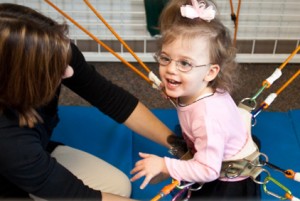While cerebral palsy and muscular dystrophy are two entirely different conditions, the similarities in some of the symptoms can sometimes cause confusion. It is important for everyone to understand how these two conditions differ.
Muscular Dystrophy

Muscular Dystrophy
Those with muscular dystrophy suffer from a loss of muscle tissue, and as a result they have weak muscles. It can often be genetic and is progressive in nature. Once the disorder manifests itself, the victim will continue to lose muscle tissue. It can also lead to a secondary condition such as cardiomyopathy or disturbance in the natural rhythm of the heart. Unlike cerebral palsy, muscular dystrophy only involves the muscles (instead of the muscles, speech, hearing, learning, and thought processes).
Symptoms and Treatment
There are several symptoms one might expect to find in someone who suffers from muscular dystrophy. Some of the things you might find include the following:
- Progressive (worsening) weakness of the muscles.
- Drooling.
- Droopy eyelids.
- Problems walking.
There are seven types of muscular dystrophy:
- Becker’s MD.
- Duchenne’s MD.
- Emery-Dreifuss MD.
- Limb girdle MD.
- Myotonic MD.
- Myotonia congenital MD.
- Fascioscapulohumeral MD.
The treatment of muscular dystrophy includes physical therapy along with the use of medications such as corticosteroids. Muscular dystrophy patients can also suffer from a few complications that may include cardiomyopathy (enlarged heart), breathing problems, and scoliosis.
Cerebral Palsy

Cerebral Palsy
Cerebral palsy is a broad term we use to define conditions that have an effect on a person’s posture and movement. This results because there is damage to one or more parts of the brain that are in control of movement and prevents the cerebral palsy victim from moving his or her muscles in a normal manner. This damage occurs during pregnancy, during birth, or shortly thereafter, often as the result of medical malpractice. The symptoms a person with cerebral palsy might experience can range from mild to severe, and in some cases may involve partial paralysis.
Even though cerebral palsy is not a progressive disease like muscular dystrophy (or even a disease at all for that matter), the patient may suffer from the following:
Like muscular dystrophy, there is more than one type of cerebral palsy. Where muscular dystrophy has seven main types, cerebral palsy has three (and many variations of these three).
There are a variety of things that could occur during pregnancy or the time the baby is born that can have a negative effect on the normal development of the brain and lead to the development of cerebral palsy. In nearly three-quarters of cases, the brain damage occurs while the baby is still in the womb although it may also occur during the first few months following the birth.
